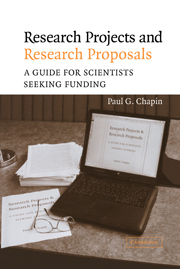Book contents
- Frontmatter
- Contents
- Foreword
- Acknowledgments
- Introduction
- 1 Selecting a Research Topic
- 2 Project Planning
- 3 Identifying Funding Sources
- 4 Special Funding Mechanisms
- 5 Writing a Proposal
- 6 Research Ethics and Responsibilities
- 7 The Natural History of a Proposal
- 8 “We Are Happy/Sorry to Inform You …”
- 9 Managing Your Grant
- Appendix A Glossary of Acronyms
- Appendix B Useful URLs
- Index
1 - Selecting a Research Topic
Published online by Cambridge University Press: 14 July 2009
- Frontmatter
- Contents
- Foreword
- Acknowledgments
- Introduction
- 1 Selecting a Research Topic
- 2 Project Planning
- 3 Identifying Funding Sources
- 4 Special Funding Mechanisms
- 5 Writing a Proposal
- 6 Research Ethics and Responsibilities
- 7 The Natural History of a Proposal
- 8 “We Are Happy/Sorry to Inform You …”
- 9 Managing Your Grant
- Appendix A Glossary of Acronyms
- Appendix B Useful URLs
- Index
Summary
Every research project begins with an idea – a question whose answer nobody knows yet, and a guess as to what that answer might be. Finding the right question to ask is often the most difficult task facing the researcher. The best scientists seem to have a knack for formulating interesting, productive research topics. Although it is probably beyond the ability of a book or a teacher to impart this skill directly, we can identify some of the distinguishing characteristics of a well-chosen research topic.
The context constrains the choice. This book is about planning and proposing research projects for funding, so that is the context we will assume here. Other contexts, such as selecting a topic for a term paper or for a lifelong pursuit, might lead to a different choice.
A good research topic successfully balances a set of desirable but conflicting goals. These goals fall into a number of opposing pairs that you can think of as the endpoints or poles of dimensions that describe the topic.
The Dimensions of Topic Selection
1. Focused vs. Extended. Research is an attempt to shine a beam of light into a dark place. Like a beam of light, research can be focused more or less sharply, and the choice of focus can be a key to determining how fruitful the research turns out to be.
The topical focus must be clear and sharp.
- Type
- Chapter
- Information
- Research Projects and Research ProposalsA Guide for Scientists Seeking Funding, pp. 4 - 12Publisher: Cambridge University PressPrint publication year: 2004



